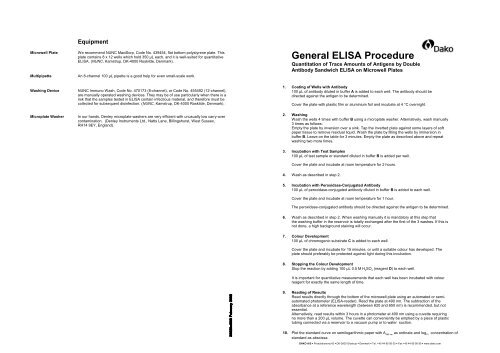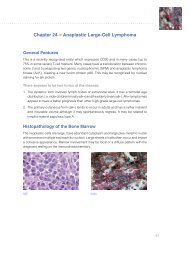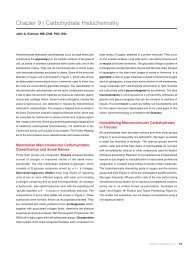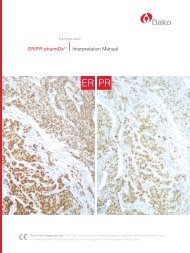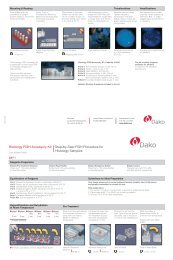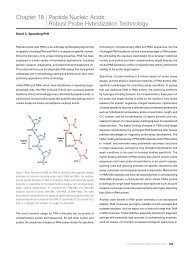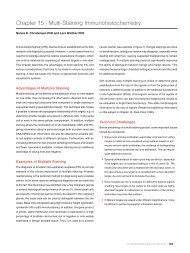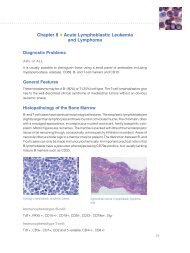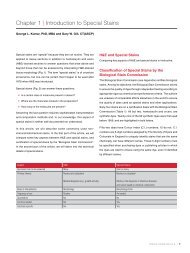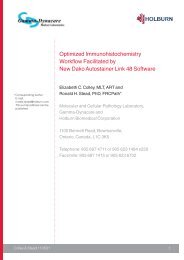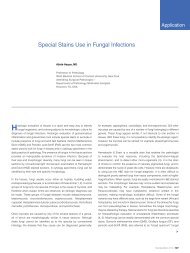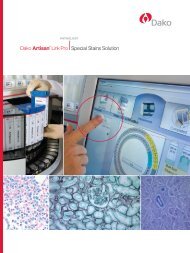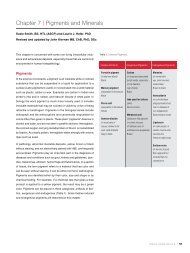General ELISA Procedure - Dako
General ELISA Procedure - Dako
General ELISA Procedure - Dako
Create successful ePaper yourself
Turn your PDF publications into a flip-book with our unique Google optimized e-Paper software.
Equipment<br />
Microwell Plate We recommend NUNC MaxiSorp, Code No. 439454, flat bottom polystyrene plate. This<br />
plate contains 8 x 12 wells which hold 350 µL each, and it is well-suited for quantitative<br />
<strong>ELISA</strong>. (NUNC, Kamstrup, DK-4000 Roskilde, Denmark).<br />
Multipipette An 8-channel 100 µL pipette is a good help for even small-scale work.<br />
Washing Device NUNC Immuno Wash, Code No. 470173 (8-channel), or Code No. 455492 (12-channel),<br />
are manually operated washing devices. They may be of use particularly when there is a<br />
risk that the samples tested in <strong>ELISA</strong> contain infectious material, and therefore must be<br />
collected for subsequent disinfection. (NUNC, Kamstrup, DK-4000 Roskilde, Denmark).<br />
Microplate Washer In our hands, Denley microplate washers are very efficient with unusually low carry-over<br />
contamination. (Denley Instruments Ltd., Natts Lane, Billingshurst, West Sussex,<br />
RH14 9EY, England).<br />
<strong>General</strong> <strong>ELISA</strong> <strong>Procedure</strong><br />
Quantitation of Trace Amounts of Antigens by Double<br />
Antibody Sandwich <strong>ELISA</strong> on Microwell Plates<br />
1. Coating of Wells with Antibody<br />
100 µL of antibody diluted in buffer A is added to each well. The antibody should be<br />
directed against the antigen to be determined.<br />
Cover the plate with plastic film or aluminium foil and incubate at 4 °C overnight.<br />
2. Washing<br />
Wash the wells 4 times with buffer B using a microplate washer. Alternatively, wash manually<br />
3 times as follows:<br />
Empty the plate by inversion over a sink. Tap the inverted plate against some layers of soft<br />
paper tissue to remove residual liquid. Wash the plate by filling the wells by immersion in<br />
buffer B. Leave on the table for 3 minutes. Empty the plate as described above and repeat<br />
washing two more times.<br />
3. Incubation with Test Samples<br />
100 µL of test sample or standard diluted in buffer B is added per well.<br />
Cover the plate and incubate at room temperature for 2 hours.<br />
4. Wash as described in step 2.<br />
5. Incubation with Peroxidase-Conjugated Antibody<br />
100 µL of peroxidase-conjugated antibody diluted in buffer B is added to each well.<br />
Cover the plate and incubate at room temperature for 1 hour.<br />
The peroxidase-conjugated antibody should be directed against the antigen to be determined.<br />
6. Wash as described in step 2. When washing manually it is mandatory at this step that<br />
the washing buffer in the reservoir is totally exchanged after the first of the 3 washes. If this is<br />
not done, a high background staining will occur.<br />
7. Colour Development<br />
100 µL of chromogenic substrate C is added to each well.<br />
Cover the plate and incubate for 15 minutes, or until a suitable colour has developed. The<br />
plate should preferably be protected against light during this incubation.<br />
8. Stopping the Colour Development<br />
Stop the reaction by adding 100 µL 0.5 M H 2 SO 4 (reagent D) to each well.<br />
It is important for quantitative measurements that each well has been incubated with colour<br />
reagent for exactly the same length of time.<br />
9. Reading of Results<br />
Read results directly through the bottom of the microwell plate using an automated or semiautomated<br />
photometer (<strong>ELISA</strong>-reader). Read the plate at 490 nm. The subtraction of the<br />
absorbance at a reference wavelength (between 620 and 650 nm) is recommended, but not<br />
essential.<br />
Alternatively, read results within 3 hours in a photometer at 490 nm using a cuvette requiring<br />
no more than a 200 µL volume. The cuvette can conveniently be emptied by a piece of plastic<br />
tubing connected via a reservoir to a vacuum pump or to water suction.<br />
10. Plot the standard curve on semilogarithmic paper with A 490 nm as ordinate and log 10 concentration of<br />
standard as abscissa.<br />
DAKO A/S • Produktionsvej 42 • DK-2600 Glostrup • Denmark • Tel. +45 44 85 95 00 • Fax +45 44 85 95 95 • www.dako.com
Comments on Procedural Steps<br />
Step 1 Coating of Wells with Antibody<br />
Step 2 Washing<br />
a. Use the immunoglobulin fraction of the antiserum for coating, not whole, unprocessed<br />
antiserum.<br />
b. The protein concentration of diluted antibody should be about 10 mg per L (optimal<br />
concentration).<br />
c. Coating at room temperature for 1 hour is possible, but coating at 4 °C overnight increases<br />
sensitivity and precision of the assay.<br />
d. Dilution of the antibody in buffer A gives <strong>ELISA</strong> results comparable to those obtained with the<br />
commonly used 0.05 M carbonate buffer, pH 9.6.<br />
e. Microwell plates may be precoated and stored at 4 °C for several months, if the coating is<br />
performed as follows: Dilute the antibody in buffer A and make the solution 0.01% in<br />
thimerosal. Add 100 µL antibody to each well and store the plate wrapped in plastic film at<br />
4 °C.<br />
The 0.1% Tween 20 in the washing buffer reduces the background and should be preferred<br />
for 0.05% Tween 20, which is commonly used. An automated microplate washer is<br />
recommended, in particular for <strong>ELISA</strong>s where infectious materials are handled and wastage<br />
must be collected for disinfection.<br />
Step 3 Incubation with Test Samples<br />
a. <strong>General</strong>ly, biological samples should be diluted at least 1+1 to reduce the risk of non-specific<br />
reactions.<br />
b. Detection limit: Using the given general procedure, the detection limit is about 1 to 5 µg of<br />
antigen per L of test sample. The sensitivity of a given antigen/antibody system might be<br />
improved if the sample is made 3% in polyethyleneglycol MW 6000. Further, the sensitivity<br />
will be improved by prolonging the incubation time, for example by incubating the plate -<br />
covered with plastic film - at 4 °C overnight.<br />
Step 5 Incubation with Peroxidase-Conjugated Antibody<br />
a. It might speed up the reaction and improve the sensitivity if the peroxidase-conjugated<br />
antibody is made 3% in polyethyleneglycol MW 6000. In addition, the sensitivity might be<br />
improved if the incubation time is prolonged 1 or 2 hours.<br />
b. The dilution of the peroxidase-conjugated antibody should be adjusted according to the<br />
wanted measuring range. Usually, dilutions between 1:500 and 1:2000 are suitable.<br />
Reagents<br />
A. Coating Buffer 0.01 M Phosphate Buffer, 0.15 M NaCl, pH 7.2<br />
NaH 2 PO 4 , H 2 O 0.35 g<br />
Na 2 HPO 4 , 2H 2 O 1.34 g<br />
NaCl 8.47 g<br />
H 2 O ad 1 litre - check pH (7.2 ± 0.2)<br />
Store at 4 °C. Stable for 2 months. (12 mL of buffer A is needed for one microwell plate).<br />
B. Washing Buffer, 0.01 M Phosphate Buffer, 0.50 M NaCl, 0.1% Tween 20, pH 7.2<br />
Dilution Buffer<br />
NaH 2 PO 4 , H 2 O 0.35 g<br />
Na 2 HPO 4 , 2H 2 O 1.34 g<br />
NaCl 29.22 g<br />
Tween 20<br />
(Merck, No. 822184) 1 mL<br />
H 2 O ad 1 litre - check pH (7.2 ± 0.2)<br />
Store at 4 °C. Stable for 2 months. (1 to 3 litres of buffer B is needed for one microwell plate).<br />
C. Chromogenic Buffer-containing<br />
Substrate OPD tablets of 2 mg 4 (DAKO OPD Tablets, Code No. S 2045)<br />
H 2 O 12 mL<br />
Allow the tablets to dissolve, then add<br />
30% H 2 O 2 5 µL<br />
Prepare the reagent shortly before use. Remember that the chromogenic substrate should<br />
have reached room temperature before use. After the addition of H 2 O 2 the reagent should be<br />
watched a few minutes to ascertain that it remains slightly yellow. If the reagent colours<br />
increasingly, it has been contaminated with peroxidase from unclean glassware or other<br />
source.<br />
The solution is stable at 24 °C for at least 2 hours if protected from light. The given volume is<br />
suitable for one microwell plate.<br />
Note: If only OPD tablets without buffer salts are available, the H 2 O should be replaced by a<br />
0.1 M citric acid-phosphate buffer, pH 5.2, prepared as follows: citric acid,H 2 O 7.30 g,<br />
Na 2 HPO 4 ,2H 2 O 13.71 g, H 2 O ad 1 litre. Store at 4 °C. Stable for 2 months.<br />
D. 0.5 M Sulphuric Acid 28 mL 95 - 97% H 2 SO 4 is mixed into about<br />
900 mL distilled water.<br />
Note: Do not mix the water into the concentrated acid (risk of boiling).<br />
Adjust the volume to 1 litre with distilled water. (About 15 mL of reagent D is needed for one<br />
microwell plate).


